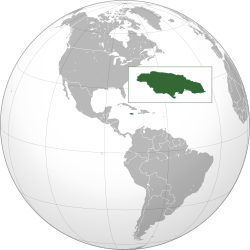Portal:Jamaica
The Jamaica Portal
Jamaica (/dʒəˈmeɪkə/ jə-MAY-kə; Jamaican Patois: Jumieka [dʒʌˈmie̯ka]) is an island country in the Caribbean Sea and the West Indies. At 10,990 square kilometres (4,240 sq mi), it is the third largest island—after Cuba and Hispaniola—of the Greater Antilles and the Caribbean. Jamaica lies about 145 km (90 mi) south of Cuba, 191 km (119 mi) west of Hispaniola (the island containing Haiti and the Dominican Republic), and 215 km (134 mi) south-east of the Cayman Islands (a British Overseas Territory). With 2.8 million people,0 Jamaica is the third most populous Anglophone country in the Americas (after the United States and Canada), and the fourth most populous country in the Caribbean. Kingston is the country's capital and largest city. Most Jamaicans are of Sub-Saharan African ancestry, with significant European, East Asian (primarily Chinese), Indian, Lebanese, and mixed-race minorities. Because of a high rate of emigration for work since the 1960s, there is a large Jamaican diaspora, particularly in Canada, the United Kingdom, and the United States. The country has a global influence that belies its small size; it was the birthplace of the Rastafari religion, reggae music (and such associated genres as dub, ska and dancehall), and it is internationally prominent in sports, including cricket, sprinting, and athletics. Jamaica has sometimes been considered the world's least populous cultural superpower. (Full article...) Selected article -The Jamaican honours system has developed as a unique entity since the passage of the National Honours and Awards Act by the Parliament of Jamaica in 1969 (Act No. 21 of 1969). The system is modelled largely on the British honours system, which was formerly conferred on Jamaicans. The Governor-General is the Chancellor of each order, membership of which is conferred by the Governor-General upon the advice of the Prime Minister of Jamaica. The sovereign is not, however, the sovereign of these orders, as in the case of the Order of Canada and the Order of Australia. In a sense, therefore, they are somewhat analogous to those distinctions awarded by certain of the Canadian provinces. (Full article...)Did you know (auto-generated)
Selected biography -Percival Noel James Patterson, ON, OCC, KC (born 10 April 1935), popularly known as P.J. Patterson, is a Jamaican former politician who served as the sixth Prime Minister of Jamaica from 1992 to 2006. He served in office for 14 years, making him the longest-serving prime minister in Jamaica's history. He was the leader of the People's National Party from 1992 to 2006. Patterson served as the Member of Parliament (MP) for the constituency of Westmoreland South Eastern from 1970 to 1980 (when he lost to Euphemia Williams of the Jamaica Labour Party) and again from 1989 to 1993. Following a constituency reorganization, he served as the MP for Westmoreland Eastern from 1993 to 2006. He retired from all of these positions in January 2006. (Full article...)General images -The following are images from various Jamaica-related articles on Wikipedia.
This is a Good article, an article that meets a core set of high editorial standards.
The 1944 Jamaica hurricane was a deadly major hurricane that swept across the Caribbean Sea and Gulf of Mexico in August 1944. Conservative estimates placed the storm's death toll at 116. The storm was already well-developed when it was first noted passing westward over the Windward Islands into the Caribbean Sea on August 16. A ship near Grenada with 74 occupants was lost, constituting a majority of the deaths associated with the storm. The following day, the storm intensified into a hurricane, reaching its peak strength on August 20 with maximum sustained winds of 120 mph (195 km/h). At this intensity, the major hurricane made landfall on Jamaica later that day, traversing the length of the island. The damage wrought was extensive, with the strong winds destroying 90 percent of banana trees and 41 percent of coconut trees in Jamaica; the overall damage toll was estimated at "several millions of dollars". The northern coast of Jamaica saw the most severe damage, with widespread structural damage and numerous homes destroyed across several parishes. In Port Maria, the storm was considered the worst since 1903. Land interaction weakened the hurricane, and the storm maintained this lessened intensity as it passed the Cayman Islands, producing measured gusts of 80–90 mph (130–140 km/h). On August 22, the hurricane moved ashore the Yucatán Peninsula near Cozumel and eventually emerged into the Bay of Campeche as a tropical storm. On August 24, the storm made landfall for a final time near Tampico, Mexico, bringing with it heavy rains that caused flooding throughout the coasts of Veracruz and Texas, killing 12. The storm dissipated over the mountainous terrain of inland Mexico later that day. Heavy rains were reported across the Rio Grande Valley, causing minor flooding. A tornado produced by the storms killed one person in McCook, Texas and injured fifteen others. (Full article...)Selected picture -Selected cuisines, dishes and foods -Rice and peas or peas and rice are traditional rice dishes within some Caribbean countries. The 'peas' used in this dish by some countries are traditionally pigeon peas otherwise called 'Gungo peas' in the Caribbean. Either kidney beans (red peas) or pigeon peas are generally used for this dish. Rice and peas recipes throughout the Caribbean vary, with each country having their own way of making it and name of calling it, and are similar only by the two main ingredients which are the legumes (peas/beans) used and rice to form a mixture. The name "rice and peas" originally is used by Jamaicans to identify the dish, while other countries have different names for it. In 1961, Frederic G. Cassidy made note that the dish had been referred to as Jamaica's coat of arms. (Full article...)
More did you know
Selected listsTopicsCategoriesRelated portals
WikiProjectsGeographical:
History and Society:
Tasks
Associated WikimediaThe following Wikimedia Foundation sister projects provide more on this subject:
More portals | ||||||||||||























































